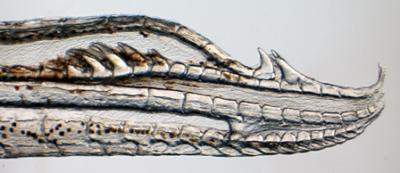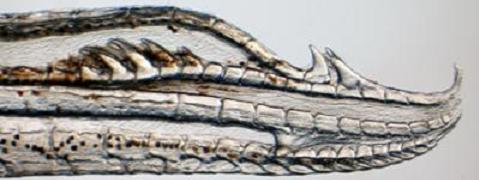Hooking Up – New Fish Discovered. With Barbed Penis
A gentleman takes his weight on his elbows. A true gentleman sleeps on the wet patch.
Sexual etiquette is something of a minefield. Ask Julian Assange.
But one thing that seems established at any rate, is that having a barbed penis studded with hooks designed to embed themselves into the tender flesh of a sexual partner, would be a bit rude (this supposition is of course subject to being proved wrong by a slew of questionable PornHub clips arriving in the Trebuchet inbox any minute now).
Or, it would be rude without some sort of consent being established in advance of the act. Let’s not judge.
Nevertheless, no such supposition applies in the piscine world, where fish with barbed, er, choppers, go at it undaunted. At least, the fish with the barbs go at it undaunted. Doubtless, the receiving fish feel differently.

A magnified view of the four hooked genitalia of the newly identified fish species Gambusia quadruncus.
And let’s not get into the old ‘she was asking for it, m’lud’ argument, just because the female fishies in question swim around with a suggestive ‘colorful anal spot’. The rights of a female fish to decorate her nethers in whatever fashion she chooses should never be taken to mean that she’s out looking for a quick hook.
The newly-discovered fish species Gambusia quadruncus, found in east-central Mexico by a research team from North Carolina State University, displays a physiology that demonstrates a gender battle which has raged throughout its evolution. In the females – an evolved ball of tissue designed to block access to male genitalia. In males – the barbed riposte.
Dr Brian Langerhans, assistant professor of biology at NC State and the lead author of the paper, suggests that ‘Having four hooks on the gonopodium may provide a means of overcoming female resistance’.
Charming.
“Typically, reproduction is more costly in females, so females favor ways of reducing mating with ‘lower quality’ males,” Langerhans says, “but reproduction is cheap in males and so selection favors ways of mating with as many females as possible. In Gambusia, some females, including G. quadruncus, have evolved modifications that appear to function as a blocking device – essentially a big ball of tissue blocking most of the genital pore – restricting entry of the male’s gonopodial tip. Thus, the female would have to behaviorally allow the male to mate or the male would have to evolve a counter response to avoid this problem.”
And that provocative anal spot?
“The differing, species-specific female anal spots appear to influence male mating behavior by signaling the location of the gonopore to the male, sometimes indicating the reproductive status of the female, and distinguishing fish of their own species from fish of other species to reduce costly cross-breeding, which can result in fish with reduced fitness,” Langerhans says. “So it may be that G. quadruncus evolved different anal spots to help reduce interspecies matings and possible formation of hybrids.”
It would seem that fish are a feminist issue
Source: North Carolina State University
Image: Brian Langerhans, NC State University

The aim of art is to represent not the outward appearance of things, but their inward significance. – Aristotle




















